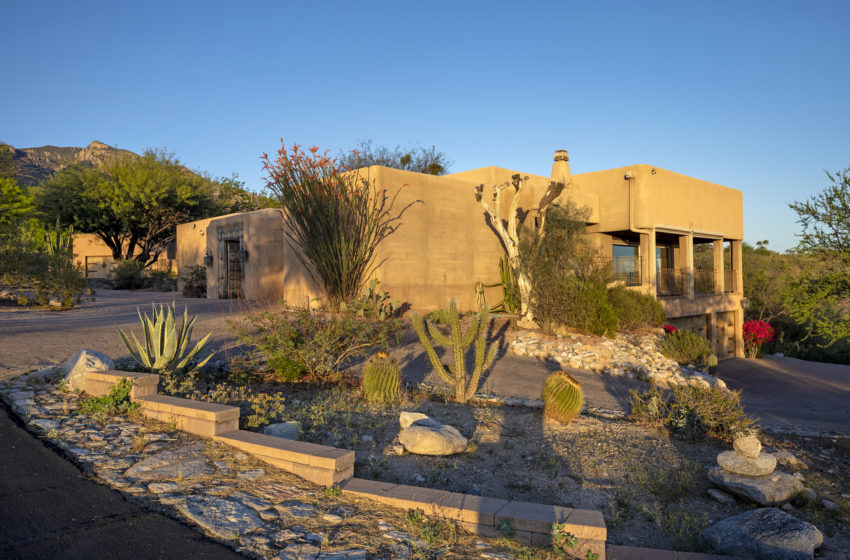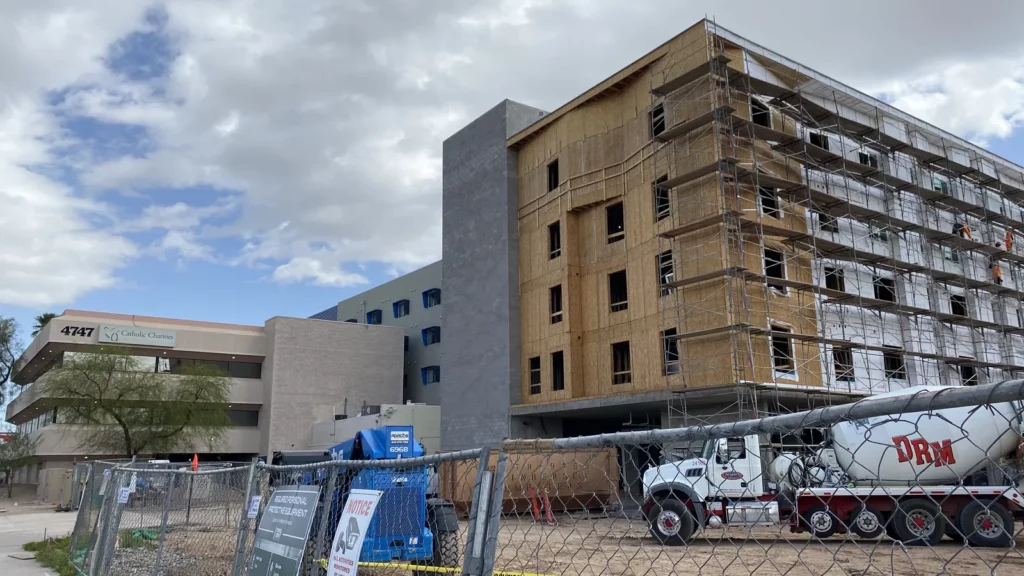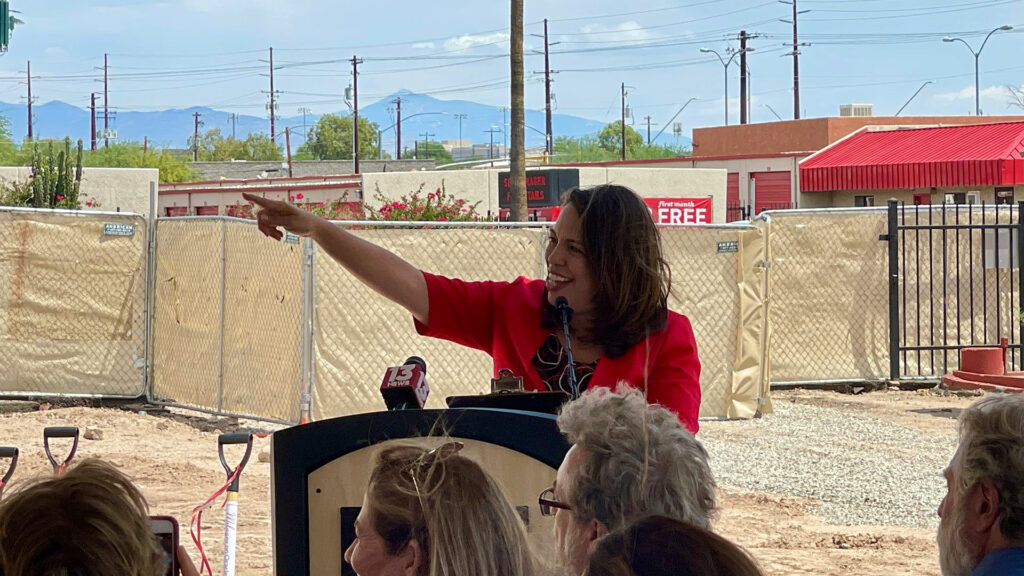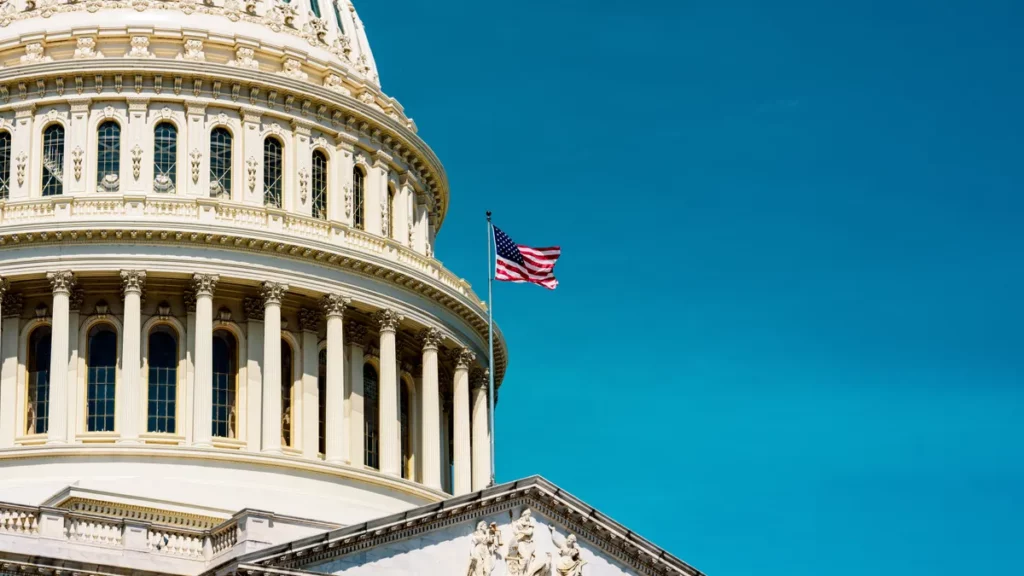Arizona’s low-income renters have little chance of finding a home. Here’s why

Contemporary adobe home with desert landscaping near sunset with mountain backdrop in Tucson, AZ.
Arizona’s housing shortage and rapidly rising rents are hurting people with the lowest incomes the most, forcing a growing number of struggling tenants out of their homes.
In metro Phoenix, which is among the top 10 metro areas facing the most severe affordable housing shortages, only 20 rentals are available for every 100 extremely low-income renters, according to the latest annual survey by the nonprofit National Low Income Housing Coalition.
The Phoenix area led the U.S. for rent increases with a 30% jump last year, and rents could climb another 20% this year.
Too few apartments, a growing population, rent increases wildly outpacing income gains and a buying spree of Phoenix-area complexes by corporate investors has created a nightmare situation for many renters.
Tenants with lower incomes have the fewest options, despite housing vouchers and federal money going to new programs and apartments.
James Lawrence and Arlinda Whidehat live in an affordable three-bedroom downtown Phoenix apartment with their two children and a teenage relative. Their monthly rent costs about 30% of their income, which is considered a healthy standard for affordability.
“We feel very lucky,” said Lawrence, who is a recovery support specialist at a care facility. “It was difficult to find an affordable apartment in a decent location when we moved here in 2020, but now it’s so much harder.”
He said their previous apartment was affordable but in a high-crime neighborhood.
The family’s complex is owned by Native American Connections, which develops affordable housing that also provides supportive community programs for residents.
When Lawrence and Whidehat lost a relative to COVID-19 last year and needed to take in two of her children, their apartment owner gave them a hardship grant.
The nonprofit has been able to keep its rent increases well below the average increases for metro Phoenix.
“There is the idea of build, build, build, which is great, but we need to make sure we are preserving affordable housing,” said Joan Serviss, executive director of the Arizona Housing Coalition. “We need to make sure some housing doesn’t fall out of affordability and that it’s diverse housing.”
Arizona’s housing shortage
Arizona needs 270,000 additional homes to tackle its housing crisis, according to the state’s Housing Department.
But that number could be growing because of the record number of affordable complexes being purchased by corporate investors that are raising rents and no longer taking housing vouchers.
Arizona ranks in the top five states where the affordable housing shortage is the worst, according to the National Low Income Housing Coalition’s latest annual survey
For every 100 families in Arizona with incomes below the poverty line or less than 30% of the median income in their areas, there are only 26 affordable and available rentals.
No state has an adequate supply of affordable housing for low-income renters, but nationally the rate is 37 homes are available for every 100 low-income renters.
A rental is affordable if a household spends 30% or less of its paycheck on rent and utilities. The majority of low-income families in Arizona spend more than half of their income on housing costs, leaving very little room for savings or an emergency.
“There’s just not enough housing supply across the board,” said Ashlee Tziganuk, a research analyst with the Morrison Institute for Public Policy at Arizona State University.
The Morrison Institute recently published “’You Feel Like a Failure’: Experiences of Housing Insecurity in Maricopa County,” using the words of anonymous focus group participants to help describe the affordability crisis.
The study found to afford a two-bedroom apartment in the Phoenix metro area in 2021, a worker needed to earn $24 per hour. However, many of the people Morrison talked to in focus groups were making $13 to $15 per hour.
Wages have not kept up with rent increases. Average rents in metro Phoenix increased by more than 60% from 2014-2021, according to data from the online real estate firm Zillow. Average hourly wages, though, increased by only 23% during that same period, according to wage data from the Bureau of Labor Statistics.
“This is probably not the right word, but, like redlining, you’re almost pushed to live where it’s not so safe because that’s what you could afford,” said one Morrison focus group member about renting in metro Phoenix.
Formula for housing crisis
A confluence of historical, economic and political factors have led to Arizona’s current housing crisis, experts say.
Serviss said the three top barriers to getting enough affordable housing are political will, financial resources and community support.
Stimulus money is helping finance more Arizona affordable housing projects, but the not-in-my-backyard-ism from neighbors of planned apartments is putting pressure on politicians to not back them.
At least 30 apartment developments stalled or were shelved across metro Phoenix in 2021 due to NIMBYism, zoning battles and political backlash.
“There’s really intense competition for everything, regardless of price point,” said Liza Kurtz, a research analyst with Morrison. “Because vacancy rates are historically low for the state in general but particularly for Maricopa County, landlords can afford to be very choosy about who they rent to because you have so many applicants for one open apartment.”
Metro Phoenix’s apartment vacancy rate is hovering around 4%, nearly the lowest in 50 years.
The private market has not done enough to make housing affordable to the lowest income renters, according to the National Low Income Housing Coalition.
“The private market cannot, on its own, provide homes affordable to these renters, because the rents affordable to extremely low-income renters will not cover the development and operating costs of new housing and often do not provide sufficient incentives for landlords to maintain older housing,” according to the national housing coalition.
Rent crunch worse for some
The rental crisis disproportionately affects Black, Latino and Native American people, who are more likely to be renters and more likely to be extremely low income.
Black renters make up 16% of households in Arizona who are extremely low-income renters, according to the national housing coalition.
Native American renters account for 14% of the state’s lowest income tenants. Latino renters make up 12%, and Asian renters 10%.
Only 5% of Arizona’s extremely low-income renters are white.
About one in five extremely low-income renters across the states are seniors or people with disabilities.
“A historical legacy of racism is acting through economic means in the housing market,” Kurtz said. “There’s a cascading number of issues that impacts lower income people disproportionately, which means people of color are also disproportionately affected.”
“I didn’t take my partner (to rental offices) because he has tattoos, so they look at him like, ‘Oh, he’s a gang banger or something,’ and he’s not,” said another Morrison focus group participant.
Housing solutions
Morrison’s research offers these potential solution to Arizona’s rental housing crisis.
Change fair market rents for neighborhoods. Most housing vouchers are tied to a rent set by the U.S. Department of Housing and Urban Development. There’s one rent range set for all of Maricopa County that only changes once a year. But rents can vary greatly by Valley. Municipalities could work with HUD to recalculate those set rents and update them more often.
Streamline the Section 8 voucher process for landlords. A growing number of Arizona landlords, especially recent corporate investors, aren’t taking housing vouchers now because they say they are “bureaucratic and inefficient.” Morrison recommends more local landlord outreach and education programs for the vouchers.
Expand eligibility for subsidized housing. Income levels for Arizona’s low-income tax credit program could be expanded so more renters qualify.
Prevent landlords from discriminating against certain incomes. Legislation or policy changes could be passed or adopted so Arizona property owners can’t turn down renters because they rely on Social Security income or housing assistance.
Provide housing navigators. Many renters said it was too difficult to navigate metro Phoenix housing-aid programs and gave up. Hiring people to assist more renters struggling to apply and qualify for housing vouchers and other aid would help.
Growing need: Glendale, Tempe plan to build affordable apartment complexes
Last week, a $5 million program between Maricopa County and low-income housing operator HOM Inc. launched to provide landlords financial incentives and support so they will rent to the growing population of people who are homeless. It doesn’t cover Section 8 vouchers now but could in the future.
President Joe Biden recently announced a housing supply action plan that aims to close the housing shortage within three years by developing new affordable housing financing mechanisms.
Also, legislation to fund the Arizona Housing Trust Fund with $100 million could pass during the current session.
But legislation to limit how much Arizona landlords can hike rents didn’t even get a hearing.
“I know people whose rents have gone up $500 a month, and they can’t afford it or find another place to live,” Lawrence said. “It’s insane and should be illegal.”
Coverage of housing insecurity on azcentral.com and in The Arizona Republic is supported by a grant from the Arizona Community Foundation.
SOURCE: https://www.azcentral.com/
Author: Catherine Reagor and Amy Qin






